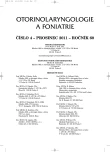Chirurgická léčba nosní polypózy
Část I.: Prognostický význam alergie, astma bronchiale a ASA senzitivity
Authors:
B. Gál
Authors‘ workplace:
Klinika otorinolaryngologie a chirurgie hlavy a krku FN u sv. Anny, Brno
přednosta prof. MUDr. R. Kostřica, CSc.
Published in:
Otorinolaryngol Foniatr, 60, 2011, No. 4, pp. 179-185.
Category:
Original Article
Overview
We present a study group of 94 patients operated on for bilateral nasal polyposis refractory to medical treatment in the Department of Otorhinolaryngology and Head and Neck Surgery of St. Anne’s University Hospital Brno between 1998 and 2005. In order to ensure homogeneity of the group, patients operated on and followed-up by one surgeon were evaluated. The extent of NP was assessed using the preoperative radiological staging according to Lund-Mackay; the median CT score was 16 points, Q0.25, Q0.75 (13.18). In 42 patients (45%) the value of radiological CT staging was higher than 16 points, which corresponds to the category of the diffuse NP. The surgery was performed in accordance with the principles of the functional endonasal surgery concept and the extent of the surgery was classified according to a surgical score. The average follow-up period was 73 (45-125) months. Determination of recurrence rate was an important criterion to evaluate the success of treatment. In the follow-up period, 24 (25.5%) recurrences were diagnosed. The median value of the recurrence-free interval was 39. months. For evaluation of the prognostic significance of systemic risk factors, the patients were divided into 4 subgroups. In the first subgroup which consisted of 29 patients without proved allergy, bronchial asthma or ASA sensitivity, no recurrence of NP was diagnosed during the follow-up period. The second subgroup consisted of patients with proved allergy without bronchial asthma and ASA sensitivity (n=15), recurrence rate was 20% (3). In the third subgroup there were patients with bronchial asthma without ASA sensitivity (n=30), recurrence rate was 27% (8). In the fourth group there were patients with ASA intolerance (n=20), recurrence rate was 65% (13). According to Kaplan-Meier analysis, the probability of recurrence 5 years after surgery in patients without risk factors was 0%, in allergy patients about 13%, in asthmatics about 17% and in patients with ASA sensitivity about 50%.
Key words:
nasal polyps, surgical treatment, recurrence rate, allergy, bronchial asthma, ASA sensitivity.
Labels
Audiology Paediatric ENT ENT (Otorhinolaryngology)Article was published in
Otorhinolaryngology and Phoniatrics

2011 Issue 4
Most read in this issue
- Orbitocellulitis and Its Therapy at the Child Age
- Transconjunctival Approach to Blow-out Fractures of Orbit in Children
- Vocal Fold Augmentation by Autologous Fat – First Experience and Preliminary Results
-
Chirurgická léčba nosní polypózy
Část III.: Symptomatické hodnocení efektu operace
